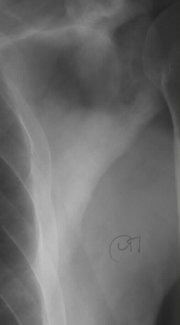Treatment of Paget's disease of bone traditionally has been limited to patients with severe disease, defined as serum alkaline phosphatase levels of more than two times the upper limit of normal, bone pain not responsive to analgesics and higher risk for complications such as fracture. Newer antiresorptive treatments, including pamidronate, alendronate, tiludronate and etidronate, offer more widespread therapeutic intervention and shorter treatment courses. Risedronate is a pyridinyl bisphosphonate that is about 1,000 times more potent than etidronate and three to five times more potent than alendronate. These attributes allow for a shorter duration of treatment at a lower dosage. Miller and associates compared the effectiveness of risedronate with that of etidronate in the treatment of Paget's disease of bone.
Patients with documented Paget's disease were included if their serum alkaline phosphatase levels were at least two times the upper limit of normal. Women were required to be postmenopausal or using contraception. Exclusion criteria consisted of comorbidities that would preclude completion of the study, and recent use of steroids, calcitonin, high doses of vitamin D, bisphosphonates, fluoride or calcitriol. Patients were randomized to receive either 30 mg of risedronate daily for two months or 400 mg of etidronate daily for six months. Because the study was double- blinded, each patient also received a placebo. The follow-up period was six to 12 months. Patients in the risedronate group took the medication (along with the etidronate placebo) with water at least 30 minutes before breakfast and refrained from lying down for one hour after taking the pill. Patients in the etidronate group took the medication (and the risedronate placebo) on an empty stomach two hours before a meal with a beverage that was not a dairy product. Serum alkaline phosphatase levels were measured at baseline and at months 1 through 6, every two months for the next six months, and again at 18 months. Quality of life was also surveyed, and adverse events were recorded.
A total of 123 patients were enrolled in the study, with 62 in the risedronate group and 61 in the etidronate group. The mean serum alkaline phosphatase level was 4.5 times the upper limit of normal, and most patients reported bone pain. Both groups showed a decrease in serum alkaline phosphatase level from baseline, but patients in the risedronate group had significantly lower levels. These patients also reported a significant reduction in bone pain. At six months, serum alkaline phosphatase levels were 33 percent lower in the etidronate group and 69 percent lower in the risedronate group-the maximal decrease for both groups. At 12 months, 73 percent of the risedronate group had achieved biochemical remission, compared with only 15 percent of the etidronate group. Relapse was also less likely in the risedronate group. By the end of the study period, 53 percent of patients in the risedronate group maintained normal serum alkaline phosphatase levels, compared with only 14 percent of the etidronate group. Adverse effects occurred in about one half (47 percent) of the patients in each group, although only a few events were considered severe, and none involved esophagitis.
The authors conclude that risedronate is a safe and more effective treatment for Paget's disease of bone than the current regimen of etidronate. Risedronate provided biochemical remission in patients who had not previously responded to etidronate and also offered significant pain relief.
Miller PD, et al., for the Paget's Risedronate/Etidronate Study Group. A randomized, double-blind comparison of risedronate and etidronate in the treatment of Paget's disease of bone. Am J Med May 1999;106:513-20.
COPYRIGHT 1999 American Academy of Family Physicians
COPYRIGHT 2000 Gale Group



